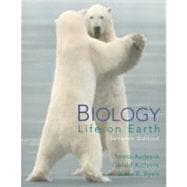
| An Introduction to Life on Earth | |
| The Life of a Cell | |
| Atoms, Molecules, and Life | |
| Biological Molecules | |
| Cell Membrane Structure and Function | |
| Cell Structure and Function | |
| Energy Flow in the Life of a Cell | |
| Capturing Solar Energy: Photosynthesis | |
| Harvesting Energy: Glycolysis and Cellular Respiration | |
| Inheritance | |
| DNA: The Molecule of Heredity | |
| Gene Expression and Regulation | |
| The Continuity of Life: Cellular Reproduction | |
| Patterns of Inheritance | |
| Biotechnology | |
| Evolution and Diversity of Life | |
| Principles of Evolution | |
| How Organisms Evolve | |
| The Origin of Species | |
| The History of Life | |
| Systematics: Seeking Order Amidst Diversity | |
| The Diversity of Viruses, Prokaryotes, and Protists | |
| The Diversity of Fungi | |
| The Diversity of Plants | |
| Animal Diversity I: Invertebrates | |
| Animal Diversity II: Vertebrates | |
| Plant Anatomy and Physiology | |
| Plant Anatomy and Nutrient Transport | |
| Plant Reproduction and Development | |
| Plant Responses to the Environment | |
| Animal Anatomy and Physiology | |
| Homeostasis and the Organization of the Animal Body | |
| Circulation | |
| Respiration | |
| Nutrition and Digestion | |
| The Urinary System | |
| Defenses Against Disease | |
| Chemical Control of the Animal Body: The Endocrine System | |
| The Nervous System and the Senses | |
| Action and Support: The Muscles and Skeleton | |
| Animal Reproduction | |
| Animal Development | |
| Behavior and Ecology | |
| Animal Behavior | |
| Population Growth and Regulation | |
| Community Interactions | |
| How do Ecosystems Work? | |
| Earth's Diverse Ecosystems | |
| Table of Contents provided by Publisher. All Rights Reserved. |
The New copy of this book will include any supplemental materials advertised. Please check the title of the book to determine if it should include any access cards, study guides, lab manuals, CDs, etc.
The Used, Rental and eBook copies of this book are not guaranteed to include any supplemental materials. Typically, only the book itself is included. This is true even if the title states it includes any access cards, study guides, lab manuals, CDs, etc.